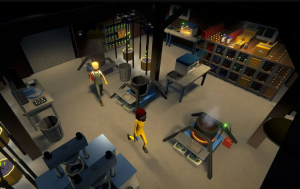



My First Encounter with Schedule I Game
I stepped into the world of Schedule I Game with a mix of anticipation and curiosity. As someone who values deep, engaging gaming experiences, I was eager to see how the game would live up to its promise of complexity and originality. The initial moments were filled with a variety of impressions—from the way the interface interacted with me to the subtle cues of narrative and design woven through the very fabric of the gameplay. I was immediately struck by the overall atmosphere, which combined elements of suspense and intimacy in a way that made me feel both challenged and welcomed.
Exploring the Gameplay Mechanics
The core gameplay of Schedule I Game is an adventure in itself. What captivated me most was the seamless integration of puzzle-solving and strategy elements with real-time decision-making. It is not just about following a rigid structure; rather, the game presents opportunities to experiment with different approaches to challenges. Every task has layers of complexity, forcing players like me to consider multiple perspectives before making a decision. The balance between expected trajectories and unexpected twists adds depth and replayability. Every move feels calculated, and even the smallest choices can create ripples that affect subsequent events.
The Depth of the Narrative
The narrative in Schedule I Game is refreshingly intricate. In my journey, I encountered storytelling that confidently trusts its players to read between the lines. This game thrives on subtle hints, environmental storytelling cues, and dialogues that let you piece together a larger puzzle. I found that each character, no matter how minor, has a unique voice and backstory that enriches the overall story. The narrative challenges conventional storytelling in games by weaving philosophical and ethical dilemmas into the fabric of everyday decision-making within the game. I often paused to reflect on the implications of my choices and the broader themes presented throughout my play session.
Immersive World-Building
The world of Schedule I Game is vast and layered, filled with detailed settings that evoke an almost tangible sense of history and personality. Traversing through various environments, each constructed with remarkable attention to detail, I was continuously impressed by how the game designers managed to balance realism with stylized artistic flair. The cities, rural areas, and mysterious locations within the game have distinct atmospheres that create a cohesive yet diverse gaming universe. I found that every location holds secrets, stories, and an invitation to explore further. The geographic and architectural diversity is matched by the game’s commitment to intuitive navigation and environmental interaction, making exploration one of its standout features.
Interface and Usability
One of the aspects that made my experience so enjoyable was the thoughtful design of the game’s interface. The menus, heads-up display (HUD), and controls are all finely tuned to ensure that both newcomers and seasoned players can immerse themselves without feeling overwhelmed. I appreciated how the controls were customizable without compromising the intuitive feel of gameplay. The responsiveness of the controls created an experience where my inputs felt natural and impactful within the game world. Moreover, the meticulous layout of the user interface minimizes distractions, allowing the focus to remain on the immersive experience rather than on intrusive notifications or complicated menus.
Sound Design and Musical Score
If there is one element that elevated my journey through Schedule I Game, it is the sound design. The game’s musical score is an intricate tapestry of ambient sounds, melodic motifs, and thematic scores that underscore the action and tension of key moments. I was drawn into the gameplay by the carefully composed background tracks, and the sound effects were crisp and purposeful. They did not merely serve as audio cues but also as environmental elements that enriched the experience. The blending of electronic undertones with orchestral harmonies created a dynamic atmosphere that shifted gracefully between introspection and exhilaration. In many moments, I felt that the soundtrack was a character in its own right, providing emotional cues that aligned perfectly with the unfolding narrative.
Visual Style and Artistic Expression
The aesthetics of Schedule I Game are truly standout. The game’s visual style combines traditional elements with modern digital artistry to create an environment that is both familiar and innovative. The color palettes were carefully chosen to reflect the mood of each scene, transitioning from vibrant hues in moments of discovery to subdued tones during periods of introspection. I was particularly impressed by the detailed character models and the subtle animations that bring them to life. Lighting plays a critical role in setting the mood and highlighting important details in the scenery, making every frame a work of art. It’s evident that the designers invested a great deal of passion in creating visuals that are immersive and narratively significant.
Innovative Approaches to Problem Solving
One of the most exciting facets of Schedule I Game is its innovative approach to puzzles and problem-solving. Unlike many games that rely on linear challenges, this game encourages you to think outside the traditional framework. I found myself confronted with puzzles that demanded creativity and critical thinking. They often required me to draw on both logical reasoning and a deep understanding of the game’s lore. Each puzzle is carefully positioned within the storyline, so solving them not only advances the gameplay but also reveals layers of character histories and broader world-building elements. This integration of narrative and challenge created an experience where every solved puzzle felt like a hard-earned victory and deepened my attachment to the game world.
Character Development and Interaction
The character development in Schedule I Game is a testament to what can be achieved when storytelling meets interactive design. I was fortunate enough to engage with a multitude of characters who, at first glance, may have seemed ancillary but soon revealed a depth and personality that enriched every interaction. From conversations laden with subtext to actions that revealed hidden motivations, each encounter felt genuine and impactful. The interplay between the player and these characters is dynamic and unpredictable, with every conversation offering potential consequences for the future. I appreciated how the game allowed room for improvisation, letting my choices influence character arcs in unexpected and meaningful ways.
Technical Performance and Stability
Having played several demanding titles, I have come to appreciate games that perform reliably from a technical standpoint, and Schedule I Game does not disappoint. The game ran smoothly during my extended sessions, with very minimal lag or technical issues. I found that the loading times are short, and the transitions between different game states are seamless. There is a clear sign of rigorous testing and debugging, which speaks to the developers’ commitment to providing a consistent and enjoyable experience. Even in peak action sequences or highly populated environments, the game maintained a high level of performance, ensuring that my focus could remain entirely on the engaging world rather than technical distractions.
The Role of Environmental Interaction
Schedule I Game stands out for its detailed environmental interactions, which encourage exploration and experimentation. I was amazed at how many elements in the game world are interactive, from seemingly mundane objects to intricately designed landscapes that hide crucial clues to advancement. This approach makes the game world feel alive and interconnected; every object has the potential to provide insight or trigger a reaction, depending on how and when you interact with it. I often found myself backtracking to previously explored areas, re-examining details, and discovering new layers of meaning with a fresh perspective. This level of environmental engagement made my journey feel like an ongoing discovery, where every corner teemed with potential stories waiting to be uncovered.
The Emotional Landscape
What truly sets Schedule I Game apart is the emotional journey it offers. As I progressed through its meticulously crafted narrative and encountered unexpected narrative twists, I found myself deeply invested in the outcomes, both at a personal level and as part of the broader tapestry of the game world. The range of emotions—from exhilaration and hope to moments of quiet reflection—was profound and expertly paced. The game seems to understand that emotional engagement is as critical as gameplay innovation, and it manages to present scenarios that evoke thoughtful introspection. My heart raced during exciting sequences and felt palpably heavy during more contemplative moments, a testament to the game’s ability to harmonize design with story-driven experiences.
Community Engagement and Modularity
Beyond the immersive world and technical excellence, Schedule I Game also shines in its support for community engagement. I enjoyed discovering the layered support for player-created content and modifications. The game encourages creativity by offering tools and frameworks that allow players to extend and personalize the experience in unexpected ways. This modularity opens the door to a vibrant community where ideas and creations flourish, making the game not just a static piece of entertainment but a living platform that evolves with each new contribution. I have found that this level of flexibility not only augments the gameplay but also instills a sense of ownership and collaboration, as players are invited to shape the very landscape of the game world.
Interactive Storytelling Techniques
In Schedule I Game, the methods used to convey storytelling are as interactive as they are innovative. I was particularly impressed by the game’s ability to merge narrative development with player interaction seamlessly. Instead of relying on lengthy, expository sequences, the game unfolds its layers of narrative through dynamic dialogue systems and tangible, interactive environments where the backstories are often hidden in plain sight. This method of storytelling means that players like me are responsible for the pace at which the story unfolds, making us active participants rather than passive receivers of information. I continuously felt the game was in constant conversation with me, teasing insights and revealing gripping details just as I lingered in a certain area or made thoughtful choices during interactions.
Attention to Detail in Game World Construction
One of the first things that impressed me about Schedule I Game is the extraordinary attention to detail in every element of its world construction. The designers have managed to craft a landscape that is both expansive and meticulously detailed. I often found myself marveling at how each setting, no matter how transient, was imbued with a sense of history and character. Whether it was the tiny visual cues in a locked room or the grand vistas beyond the horizon, each area felt like it had been carefully curated to enhance the overall experience. This dedication to detail encourages players to invest time in even the smallest corners of the game, knowing that there is a wealth of hidden narratives and aesthetic wonders waiting to be discovered.
Complex Systems of Gameplay Interactions
Another element that contributes to the game’s standout nature is its complex system of gameplay interactions. Every mechanic in Schedule I Game seems to feed into a larger tapestry of interdependent systems. I particularly enjoyed how the simple act of exploring could sometimes lead to interactions with systems I hadn’t anticipated, such as combination puzzles or layered resource management challenges. The game requires a degree of thoughtfulness in how different mechanics work together, making the experience simultaneously challenging and rewarding. Each new system that I encountered felt both intuitive and refreshingly innovative, and the interplay between various mechanics often resulted in highly unexpected scenarios that kept me on my toes throughout my playthrough.
- Immersive narrative that encourages player engagement and critical thinking.
- Innovative gameplay mechanics combining puzzles, strategy, and real-time decision-making.
- Detailed and expansive world-building with diverse environments.
- High-quality sound design and musical score that enhances emotional immersion.
- Well-designed interface and customizable controls that ensure an accessible experience.
- Support for community engagement and modding which enriches the game’s longevity.
- The game's complexity may be overwhelming for casual players and newcomers.
- Subtle narrative cues and non-linear storytelling could lead to confusion.
- Occasionally, the unexpected twists in gameplay may disrupt the pacing for some players.



